Part IV: The Slovak Community of Cleveland
The Church
After organizing their fraternal-benefit societies, the immigrants lost no time in erecting the symbol and center of their fellowship — the church. Whether Catholics (eighty percent of all Slovaks belong to this denomination), Lutherans or Calvinists, Slovaks in both worlds have long treasured their parishes.
Several dozen families, usually acting on their own initiative, would buy lots, construct buildings, and advertise in the Old World press for priests (the advertisement usually promised an annual income of $500, five times the amount the average priest could make in Hungary), with the result that as early as 1885 there was a functioning Slovak parish in the anthracite town of Hazleton, Pennsylvania.
In 1882 Father Jaskovic had come in response to the request of the Slovaks in Hazleton. He gave them his whole-hearted cooperation in founding St. Joseph’s parish. By June 1885, the cornerstone of a simple wooden church was blessed and laid with due solemnity. On December 5, 1885, the first Mass was celebrated in the first Slovak Catholic Church in the United States.
A similar undertaking was in progress among the Slovaks of Streator in Illinois, as an energetic community built St. Stephen’s Church and celebrated their first Mass on December 11, 1885. The Slovak Lutherans of Streator had their first services in a church of their own on October 5, 1884. Also in Pennsylvania, Freeland and Nanticoke had a Lutheran Church built in 1886. These early churches were modest buildings but, over the years since these unpretentious beginnings, the Slovaks have built an impressive number of extra-ordinarily inspiring and architecturally distinguished churches in America.
However, such lay independence alarmed the largely Irish hierarchy of America which quickly asserted its supremacy over the new parishes and by so doing angered the founders. In the Old World, the faithful had observed, that if a noble built and supported a church, he could demand the appointment or removal of a pastor at will. In the United States laymen who built their own churches assumed that the same rights of “lay patronage” were theirs. Irish Bishops in America disagreed, and almost every Slovak community in the United States witnessed a struggle for control over the parish and its treasury. The combatants were usually a lay-dominated parish committee and the priest, who was supported by the Bishop. These struggles lasted throughout the first generation of immigration. The second generation, reared in America and educated by Irish nuns, who staffed most of the parochial schools, gave up the fight.
In spite of such problems, the parish, in conjunction with its several fraternal-benefit societies, became the center of Slovak communal life. Here the people congregated on Sundays, worshipped in their native tongue, socialized after church, held lodge meetings in the church basement and planned community affairs. The highlight of parish solidarity occurred at weddings and christenings. On such occasions several hundred people gathered to eat, drink and dance to the good fortune of the couple involved and the atmosphere of the Old World village was almost reborn.
Such celebrations were soon buttressed by more professional activities. In Cleveland, for instance, St. Ladislas and St. Martin parishes very early established singing societies, bands and dramatic clubs. These were usually appendages of fraternals, especially of their junior branches, and they helped preserve and promote the solidarity of the community and its culture. By the early 20th century virtually every parish engaged in such activities. And, although the practice has declined somewhat in recent years, the community still holds an annual “Slovak Day” at St. Josephat’s parish in Parma and the General Milan R. Stefanik Dramatic Circle still sponsors the occasional play.
Father Stephen Furdek
Catholic Slovaks in Cleveland had the good fortune of finding a capable priest very early, but ironically, he did not come to minister to them but to the rapidly growing Bohemian (Czech) parishes. Bishop Gilmour of Cleveland’s Roman Catholic Diocese had petitioned Prague to send a priest for the Bohemian people, and Father Furdek, although a Slovak seminarian only 24 years old was chosen to answer the call. He was ordained here in 1882 in St. Wenceslas Parish and became its pastor. Two years later he was commissioned to establish the new Bohemian parish of Our Lady of Lourdes where he remained until his death on January 18, 1915.
A man of large ability and executive talent, he not only successfully performed his appointed work among the Bohemians, but from the outset, he began to minister to the needs of the Slovak people. It was not long before he became a national figure among the Slovaks and was everywhere affectionately known as “The Father of the Slovaks.”
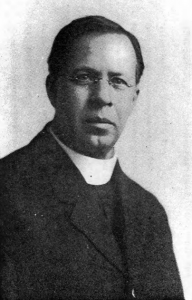
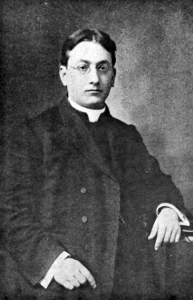
St. Ladislas
In 1885 Father Furdek began holding Slovak services regularly in the chapel of the Franciscan Brothers on Woodland Avenue, bringing together into a religious body the little group of Slovaks in Cleveland at the time. They, like the Czechs, had settled in the district around Hill, Berg, and Fourth Streets, but, at the urging of Father Furdek, moved to the then outskirts of the city along Buckeye Road and parallel streets from about East 78th Street to Woodhill Road. The settlement grew quickly and in 1887 a fund for a church was begun. The first church, St. Ladislas (named after a Magyar saint), was a combined effort of the Slovaks and Magyars who also lived in the neighborhood. Father Furdek then went to Slovakia and brought them their first pastor, Jan Matron. But, it was not long before difficulties arose between the two groups, and the Bishop of Cleveland came in as arbitrator, decreeing that the Magyars should build themselves a new church. The Slovaks were instructed to reimburse the Magyars $1,000 for their former interest in St. Ladislas.
The neighborhood around St. Ladislas changed much in the ensuing years so that by 1920 the small, neat homes of the Slovaks were crowded out by tenements, and many people moved farther out. However, sufficient numbers remained and they sent their children to St. Ladislas’ Parochial School until 1970 when a serious fire broke out. This had been the second time that fire had been destructive, but this time it was sadly noted in the Ženská Jednota (Women’s Union) that “today, with a deteriorating neighborhood, the parishioners are far too few to absorb the tremendous cost of rebuilding.” It is ironic, but now, these families who wished to continue Catholic education for their children of elementary age, were compelled to send them to the nearby Hungarian parish of St. John. However, there was no evident animosity, and it is doubtful that this generation was even aware of the earlier difficulties between the Slovak and Magyar population.
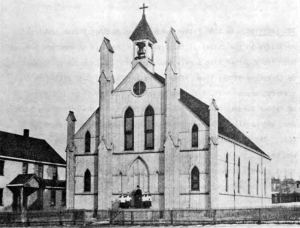
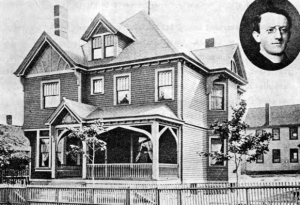
(A new St. Ladislas was built on Bassett Road in Westlake in 1974. However, it is cosmopolitan in character and the pastor doubts that even 20 percent of his parishioners are of Slovak descent.)
Holy Trinity Lutheran
On December 5, 1892, the Lutherans founded the Holy Trinity Evangelical Lutheran Congregation led by Jan Pankuch and 50 co-religionists. It was the third Slovak Lutheran parish at that time in the United States. Having secured a pastor in 1894, the laymen began to collect money for a building and in 1899 bought a lot upon which, by 1906, they erected a building costing $22,000. The church was located in the downtown district at 2506 East 20th Street, and although the local population changed entirely several times since its first beginning, the parishioners found it easy to come from allover the city until the church had to be relocated and rebuilt to make way for a city innerbelt. In 1959 a new church on Broadview Road was dedicated in Parma. (Father George P. Vojtko, the pastor at the time of this writing, estimated that he had approximately 350 families and that of these 20 percent are of Slovak descent.)
St. Martin
Some of the parishioners of St. Ladislas who preferred to live downtown close to the manufacturing plants in which they worked found the long street car ride to St. Ladislas tiresome, and so they decided to establish a local parish. In 1894 the Roman Catholics led by Michael Dlugos and Michael Kihoranyi established their second church in the same neighborhood as Holy Trinity Lutheran Church and called it St. Martin. It was first located on East 25th Street; in 1902 a church was built on East 23rd and Scovill Avenue. Having no pastor of their own, they were able to persuade Reverend W.A. Panuška, who had replaced Jan Matron at St. Ladislas, to also say Mass for them. Then, under a new pastor Father W.J. Horak, they bought a larger lot at Scovill Avenue and East 23rd Street where, in 1906 they began to build a stone neo-Gothic structure that would cost more than $100,000. The old church then plus three houses became a school. Unfortunately, in the 1960’s St. Martin, the most beautiful of all Cleveland Slovak churches, fell victim to the new innerbelt being built.
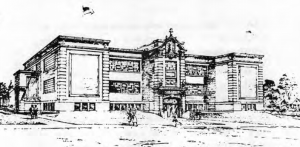
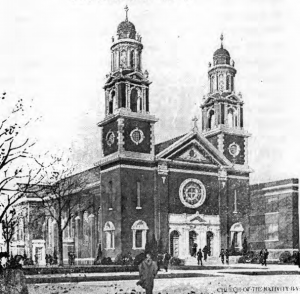
St. Wendelin
Several years after the first three Slovak churches (St. Ladislas, Holy Trinity, and St. Martin) were established, a new settlement had grown up on the West Side. After settling for a time in the district of West 17th and West 22nd Streets, Lorain Avenue and Columbus Road, the Slovaks moved into the old Lincoln Heights neighborhood between West 5th and West 11th Streets. The parish of St. Wendelin was organized in 1903, and, in that same year, a school and church were built on West 25th Street and Columbus Road. By 1928 it boasted of having 7,000 worshippers and 1,000 children in its parochial school, making it the largest single Slovak parish in Cleveland. Today St. Wendelin is still an active parish although most of its parishioners live in the suburbs.
St. Mary of the Nativity
In the neighborhood of East 93rd Street and Aetna Road the parish of St. Mary of the Nativity Roman Catholic Church was formed in 1903. It was probably an outgrowth of the St. Ladislas parish, and now they were conveniently located near the Newburgh plant of the American Steel and Wire Co., but in an area where the land was higher and the air clean and clear. Emily Balch in Our Slavic Fellow Citizens relates that some of the men in Slovakia had been compelled for economic reasons to follow a wandering trade (“tinkers” already mentioned). Most characteristic of these wanderers was the “drotár” who made all sorts of things of wire (which the name signifies), sometimes very elaborate and artistic things, but whose commonest tasks was the mending of broken earthen pots with a skillful wire network. As metal pots replaced earthenware, the demand for this service grew less, and the selling of all sorts of wire and tin goods and the like took its place. In America the wire workers often found employment for their skill in modernized forms of the same craft — making fences, gates and railings, mousetraps, and small articles, and they became tinplaters and plumbers. Since the tinware of Europe was made largely by the Slovaks, it is interesting to note that an old form of skill has been made practicable in the new country.
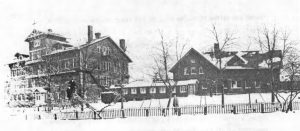
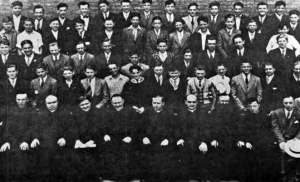
Here, near the American Steel and Wire Co. plant, the Slovaks lived in single or two-family houses with neat yards and well-tilled gardens. Much of this district’s orderly development was due to the inspiring guidance of Reverend V.A. Chaloupka. When the Slovaks first came to America, they had been compelled to live in crowded boardinghouses, but as soon as they were financially able, home ownership was a goal the majority sought. Three Slovak building and loan associations assisted them in the acquisition of property: The Tatra Savings and Loan Association on Scovill Avenue, The First Slavonian Mutual Building and Loan Association on Buckeye Road, and the Orol Building Association is the Home Federal Savings and Loan Association with a branch on Brookpark Road, and the First Slavonian Loan Association no longer exists.
The Nativity school building was erected in 1916, and it was built with features which made it a genuine community center where the Slovaks came to enjoy a play, a movie, a lecture, or a dance. Here the young people could enjoy the bowling alley, the women could work on their Red Cross projects, and, those who were learning the duties of good citizenship, came to classes often taught by the priests themselves who were many times the guiding spirit in this endeavor.
Slovak Lutherans
On the West Side, a movement of the Slovaks to the suburb of Lakewood was made so that they could be near yet another site of employment — the Union Carbide Co. on Madison Avenue and West 117th Street.
Slovak Lutherans, who arrived in Lakewood first, also led in the establishment of parishes. Initially, they organized a filial of Cleveland’s Holy Trinity but this did not satisfy all groups. One faction split off on March 21, 1901 and established SS. Peter and Paul Church at Quail and Thrush Streets. In the next two decades the Lakewood Lutherans underwent two more schisms caused by doctrinal and personal differences with the result that by 1930 they had three churches located within a few blocks of each other — SS. Peter and Paul relocated at 13028 Madison Avenue, Pentecost Evangelical Lutheran at 13303 Madison and Gethsemane Lutheran at 14560 Madison. All three still function today.
SS. Cyril and Methodius
Although Roman Catholic Slovaks came to Lakewood later than Lutherans, they lost no time in organizing. Laymen began to take up a collection in 1902. They bought a lot at the corner of Madison and Lakewood Avenues in 1903 and by 1905 had built a wooden structure dedicated to SS. Cyril and Methodius. In 1926 they felt secure enough to begin constructing a new, stone church and, once it was finished, it ranked as one of the largest and most imposing of all Slovak churches in the Cleveland area.
Slovak Calvinists
The last group of Slovaks in Lakewood to establish a parish were the Calvinists. A tiny minority of the nation, both in Europe and in America, Slovak Calvinists generally worshipped with Magyars of the same persuasion because pastors of their own nationality were almost non-existent. In 1917, 50 immigrants decided to break with the Magyars and formed branch number 33 of the Slovak Calvin Presbyterian Union, a fraternal society that had come into existence at Mt. Carmel, Pennsylvania, in 1901. Four years later they felt financially strong enough to establish their own Calvin Presbyterian Church. They bought a wooden structure from the Slovak Lutherans at Quail and Thrush Streets and began to invite Czech ministers to serve them in their native language. The parish still exists although it has no regular pastor.
With this concentration of Slovaks in Lakewood, many of whom were living then in a four-square block area known as “bird town” because many of the streets were named after birds (Robin, Lark, Quail, Thrush, and Plover), this section became known as “Little Slovakia,” according to Mrs. Margerita Mihok, Executive of the Second Czech and Slovak Cotillion Ball. She notes that residents in this southeastern portion of lakewood along Madison Avenue have lived here for 60 years or more.
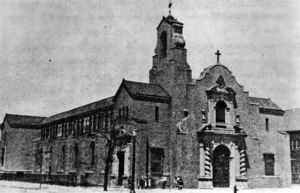
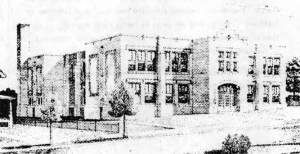
Our Lady of Mercy
Some Slovaks on the West Side of Cleveland, especially those living in the “Tremont” area, felt that St. Wendelin’s was too far away. In 1915 they petitioned Bishop Farrelly for permission to found their own parish. He refused this request because the pastor of St. Wendelin’s did not wish to lose a part of his flock. As a result, the impatient laymen broke away in 1917 and established St. John’s Independent Slovak Catholic Church at 2425 West 11th Street. Only After Farrelly had died and Joseph Schrembs had replaced him in 1922 did a reconciliation occur whereby the laymen returned to the Roman Catholic Church and the Bishop recognized their existence. Although small and carrying the new name of Our Lady of Mercy, this congregation continues to function to this day.
St. Andrew
Slovaks also settled on the northeast side of the city, in the predominantly Slovenian neighborhood around East 51st and Superior Avenue. Here they began erecting a church dedicated to St. Andrew Svorad in 1906. The Reverend Jan M. Lišcinsky, who administered the parish from 1908 to 1922, turned it over to the newly-founded Slovak Order of St. Benedict in the latter year and it then became the nucleus of the Benedictine order of teaching priests.
St. Benedict
The last of the original Catholic Slovak parishes to arise in Cleveland proper was St. Benedict’s. After the Benedictine monks had established themselves at St. Andrew’s parish, they found the facilities too small for their growing order. Thus, in 1928 they bought a large tract of land on East Boulevard between Buckeye and Lamontier and established St. Andrew’s Abbey, St. Benedict’s Church, and Benedictine High School on their new property. This large investment became the most impressive of the Slovak undertakings in the city. By serving those countrymen who began to move further east from St. Ladislas parish in the 1920’s, St. Benedict’s seemed assured of a long existence.
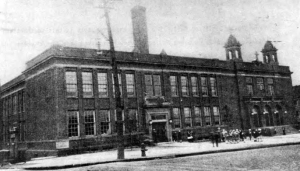
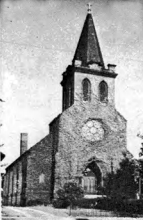
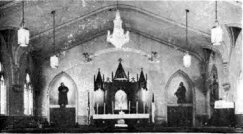
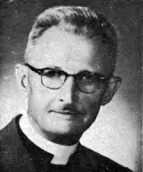
St. Andrew’s Abbey, the only Slovak abbey of the Benedictine Order, was established in 1922 as an offshoot of St. Procopius Abbey in Lisle, Illinois which was founded by the Czechs. In 1934 Reverend Stanislaus F. Gmuca, O.S.B. was elevated to the office of abbot, and at that time he was the world’s youngest abbot, Ohio’s first abbot and the only Slovak abbot in the world.
Benedictine High School was also a singular accomplishment in that in 1927 the Benedictine Fathers, using funds received from all over the country, established the first and only high school built mainly for Slovak boys. The building first used was the old St. Andrew church-school on Superior Avenue. In 1941 a new building was dedicated, and today around 600 boys of all nationalities attend the school at 2900 East Boulevard.
Martin Luther Evangelical
The Martin Luther Evangelical Congregation was founded in 1910 and used a dwelling at 2139 West 14th Street as a church until 1917. The 400th anniversary of the Reformation was celebrated by this group with the opening of a new church. Because they trace their history back to the reformation of John Huss, the coat-of-arms of this congregation is balanced by “The Cup,” the emblem of the Hussites which is their religious expression of democracy. Today they are relocated at 4470 Ridge Road which is also on Cleveland’s West Side.
Slovak Byzantine Catholics
Finally, a word needs to be said about Slovak Byzantine Catholics. These comprise about five percent of the nation and they are found chiefly in Eastern Slovakia. When they moved to the United States they established parishes, as did their Roman Catholic and Protestant counterparts, but these parishes were almost always a cooperative venture involving Ruthenians (Rusins) from Eastern Slovakia. As a result they were labeled simply “Greek Catholic” or “Byzantine” churches and were given no ethnic identification. Two such parishes in the Cleveland area had a majority of Slovak worshippers — St. Joseph’s Byzantine Catholic Church at 9321 Orleans in Newburgh and St. Gregory’s Greek Rite at the corner of Thrush and Quail Streets in Lakewood.
(G.A. Malone in the New Catholic Encyclopedia further explains that the title “Ruthenian” or “Rusin” was used by the various papal congregations and the diocesan curias to identify the Eastern Catholics in these areas: western and southwestern Russia (Galicia), in Podcarpathia, in Hungary, and in certain districts of Czechoslovakia and northern Romania. Some of the people of these districts were ethnically either Ukrainian, White Russians, Ruthenians, or Slovaks although the ecclesiastical term Ruthenian applied equally to all. However, after 1962 that ecclesiastical term was dropped in part — Ukrainian being used for the Galicians and Ruthenian for all others.)
Importance of the Church
The founding of a parish was not a chance occurrence brought about by religious fanatics, but a serious project that symbolized the people’s commitment to America, the city, and the neighborhood. Once the parishioners had invested thousands of dollars in a church structure, they were loath to leave it. Besides, the parish served both religious and social needs. On the religious side, the parishioners entered wholeheartedly in offering the sacrifice of the Mass. They entered the church singing in the vernacular, they sang during services, often holding up the priest’s portion, and they exited still singing. Before Mass the Rosary Society would meet and pray, and, after the services ended, the parishioners would gather outside to wish each other well.
Once all religious events had ended, various lodges would hold their meetings in the church basement, and, on special holydays, women’s societies would prepare a hearty lunch for the entire congregation. Thus, on Sundays the church was generally used all day, not just for a few hours in the morning. Weekdays, the parish also served as a social center. Gymnastic organizations (and later the Boy Scouts) would meet in the basement; dances, balls, and bingos would also be held there, with the result that the parish church became the focal-point of the community. As a result of their close ties to their parishes, Slovaks in Cleveland tended to identify themselves as members of a particular parish rather than as East or West Siders.
